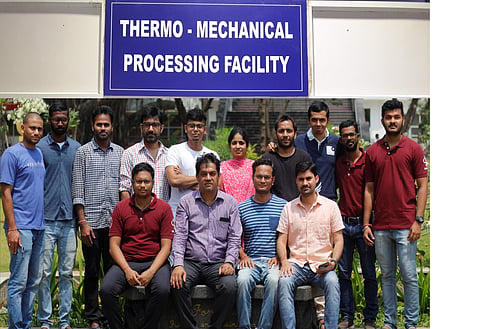

Indian Institute of Technology Madras (IITM) researchers working with the University of North Texas and US Army Research Laboratory have developed an engineered magnesium alloy with significantly improved properties, which can replace steel and aluminium alloys in automotive and aerospace components.
The current industrial application of wrought magnesium alloys in structural components is very limited due to their poor moderate/low strength, poor ductility, yield strength asymmetry and lack of high strain rate superplasticity despite their density being two-third of aluminium and one-quarter of steel. With vehicular emissions alone contributing 27 per cent of total carbon dioxide emissions, countries around the world are focusing on reducing them. A major focus has been lowering the carbon footprint of vehicles by using light-weight material in their body. Light-weight vehicles take less energy (i.e. fuel) to run and are therefore one of the strategies to increase vehicle’s energy-efficiency.
The research team has made headway in solving this challenging problem by formulating a magnesium alloy with almost zero yield asymmetry and high ductility. Their research paper has been published in the reputed peer-reviewed journal Material Research Letters. The new engineered alloy is strong, highly ductile and its superplasticity is achieved at higher strain-rates which reduces overall manufacturing time, effort and costs. In addition to this, it is also lightweight, which helps lower the carbon footprint of vehicles. Lightweight vehicles need lesser fuel to run and are therefore more fuel-efficient.
A collaborative research project on this area was carried out by Dr Sushanta Kumar Panigrahi, Associate Professor, Department of Mechanical Engineering, IIT Madras, Rajiv Mishra, University Distinguished Research Professor, University of North Texas, US, and Dr RC Brennan and. K Cho from the US Army Research Laboratory (Aberdeen Proving Grounds).
Speaking to us on how this engineered magnesium alloy will help solve the problem of vehicular emissions, Dr Panigrahi says, "Magnesium is the lightest weight metallic materials in the structural field. Being the lightest and energy-efficient structural material, magnesium (Mg) alloys offer a strong potential to replace steel and aluminium alloys in automotive and aerospace components. Weight reduction plays a significant role in reducing vehicular emissions. Reducing the average weight of new automobile vehicle (Car/Bus/Truck etc.) produces immediate net emissions savings because lighter vehicles lead to fewer energy requirements and emissions. According to the Energy Department of the US, a 10 per cent reduction in vehicle weight can result in 6-8 per cent of fuel economy improvement."
His research group is also trying to increase the load-bearing capacity of metals and alloys through microstructural engineering and processing of metals. After this feat, the team is all set to apply the same strategy of processing to other known magnesium alloys and metallic alloys with the intention of obtaining highly efficient stronger materials with superior performance. For this research, the scientists used a magnesium alloy containing rare earth elements like Gadolinium (Gd), Yttrium (Y) and Zirconium (Zr). The alloy was subjected to a thermo-mechanical processing technique (severe plastic deformation and ageing treatment) to obtain an ultrafine-grained version of this magnesium alloy. Thereafter, the team engineered the nano-precipitates and thermally stable ultrafine intermetallic compounds in the ultra-fine-grained magnesium alloy. Through this technique, the group was able to achieve the highest combination of strength-ductility and highest high strain rate superplasticity among all the existing magnesium alloys reported in the literature to date.
Called ‘Innovative Materials Processing and Characterisation Research Group’ (IMPCRG), Dr Panigrahi’s research group is a pioneer in maximising structural efficiency of any metallic material via microstructural engineering and material processing-based manufacturing approaches.
Talking about their future plans for this innovation in the automobile industry, he adds, "Despite having light-weighting potential, the current usage of wrought magnesium alloys in the automobile industry is very limited (almost negligible) due to their poor moderate/low strength, poor ductility, yield strength asymmetry and lack of high strain rate superplasticity. By using our innovative thermomechanical processing strategy in our current innovation, we are able to engineer a magnesium alloy which is super strong, ductile and negligible tension-compression asymmetry. In addition to this, it is also lightweight, which helps lower the carbon footprint of
vehicles."
"After this innovation, we are all set to apply the same strategy of processing to other known magnesium alloys and metallic alloys with the intention of obtaining high efficient stronger materials with superior performance.
At present, we are in the process to collaborate with automobile industries to translate our developed engineered Magnesium alloys in the structural components and body panels of automobiles," he concludes.
